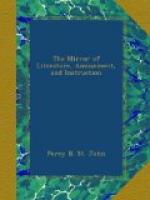Queen Elizabeth was prisoner at Richmond during the reign of her sister Mary; after she came to the throne, the palace was her favourite residence; and here she died in 1608. Charles I. formed a large collection of pictures here; and Charles II. was educated at Richmond. On the restoration, the palace was in a very dismantled state, and having, during the commonwealth, been plundered and defaced, it never recovered its pristine splendour.
The survey taken by order of parliament in 1649, affords a minute description of the palace. The great hall was one hundred feet in length, and forty in breadth, having a screen at the lower end, over which was “fayr foot space in the higher end thereof, the pavement of square tile, well lighted and seated; at the north end having a turret, or clock-case, covered with lead, which is a special ornament to this building.” The prince’s lodgings are described as a “freestone building, three stories high, with fourteen turrets covered with lead,” being “a very graceful ornament to the whole house, and perspicuous to the county round about.” A round tower is mentioned, called the “Canted Tower,” with a staircase of one hundred and twenty-four steps. The chapel was ninety-six feet long and forty broad, with cathedral-seats and pews. Adjoining the prince’s garden was an open gallery, two hundred feet long, over which was a close gallery of similar length. Here was also a royal library. Three pipes supplied the palace with water, one from the white conduit in the new park, another from the conduit in the town fields, and the third from a conduit near the alms-houses in Richmond. In 1650, it was sold for 10,000_l_. to private persons.
All the accounts which have come down to us describe the furniture and decorations of the ancient palace as very superb, exhibiting in gorgeous tapestry the deeds of kings and of heroes who had signalized themselves by their conquests throughout France in behalf of their country.
The site of Richmond Palace is now occupied by noble mansions; but an old archway, seen from the Green, still remains as a melancholy memorial of its regal splendour.
[1] Mrs. A.T. Thomson, in her Memoirs of the
Court of Henry the Eighth,
says, “On the night
of the Epiphany (1510), a pageant was introduced
into the hall at Richmond,
representing a hill studded with gold and
precious stones, and having
on its summit a tree of gold, from which
hung roses and pomegranates.
From the declivity of the hill descended
a lady richly attired, who,
with the gentlemen, or, as they were then
called, children of honour,
danced a morris before the king. On
another occasion, in the presence
of the court, an artificial forest
was drawn in by a lion and
an antelope, the hides of which were
richly embroidered with golden
ornaments; the animals were harnessed




